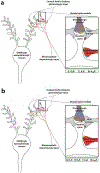Role of the central ascending neurotransmitter systems in the psychostimulant effects of caffeine
- PMID: 20182056
- PMCID: PMC9361505
- DOI: 10.3233/JAD-2010-1400
Role of the central ascending neurotransmitter systems in the psychostimulant effects of caffeine
Abstract
Caffeine is the most consumed psychoactive drug in the world. It is a non-selective adenosine receptor antagonist that in the brain targets mainly adenosine A1 and A2A receptors. The same as classical psychostimulants, caffeine produces motor-activating, reinforcing and arousing effects. This depends on the ability of caffeine to counteract multiple effects of adenosine in the central ascending neurotransmitter systems. Motor and reinforcing effects depend on the ability of caffeine to release pre- and postsynaptic brakes that adenosine imposes on the ascending dopaminergic system. By targeting A1-A2A receptor heteromers in striatal glutamatergic terminals and A1 receptors in striatal dopaminergic terminals (presynaptic brake), caffeine induces glutamate-dependent and glutamate-independent release of dopamine. These presynaptic effects of caffeine are potentiated by the release of the postsynaptic brake imposed by antagonistic interactions in the striatal A2A-D2 and A1-D1 receptor heteromers. Arousing effects of caffeine depend on the blockade of multiple inhibitory mechanisms that adenosine, as an endogenous sleep-promoting substance, exerts on the multiply interconnected ascending arousal systems. Those mechanisms include a direct A1-receptor mediated modulation of the corticopetal basal forebrain system and an indirect A2A-receptor mediated modulation of the hypothalamic histaminergic and orexinergic systems.
Figures


References
-
- Fredholm BB, Battig K, Holmen J, Nehlig A, Zvartau EE (1999) Actions of caffeine in the brain with special reference to factors that contribute to its widespread use. Pharmacol Rev 51, 83–133. - PubMed
-
- Griffiths RR, Juliano LM, Chausmer A (2003) Caffeine: Pharmacology and Clinical Effects. In Principles of Addiction Medicine, Graham AW, Schultz TK, Mayo-Smth MF, Ries RK, Wilford BB, eds, Third Edition, American Society of Addiction Medicine, Chevy Chase, pp. 193–224.
-
- Ferré S (2008) An update on the mechanisms of the psychostimulant effects of caffeine. J Neurochem 105, 1067–1079. - PubMed
-
- Griffiths RR,Woodson PP (1988) Reinforcing effects of caffeine in humans. J Pharmacol Exp Ther 246, 21–29. - PubMed
-
- Mumford GK, Holtzman SG (1991) Qualitative differences in the discriminative stimulus effects of low and high doses of caffeine in the rat. J Pharmacol Exp Ther 258, 857–865. - PubMed
Publication types
MeSH terms
Substances
Grants and funding
LinkOut - more resources
Full Text Sources
Other Literature Sources
Medical

